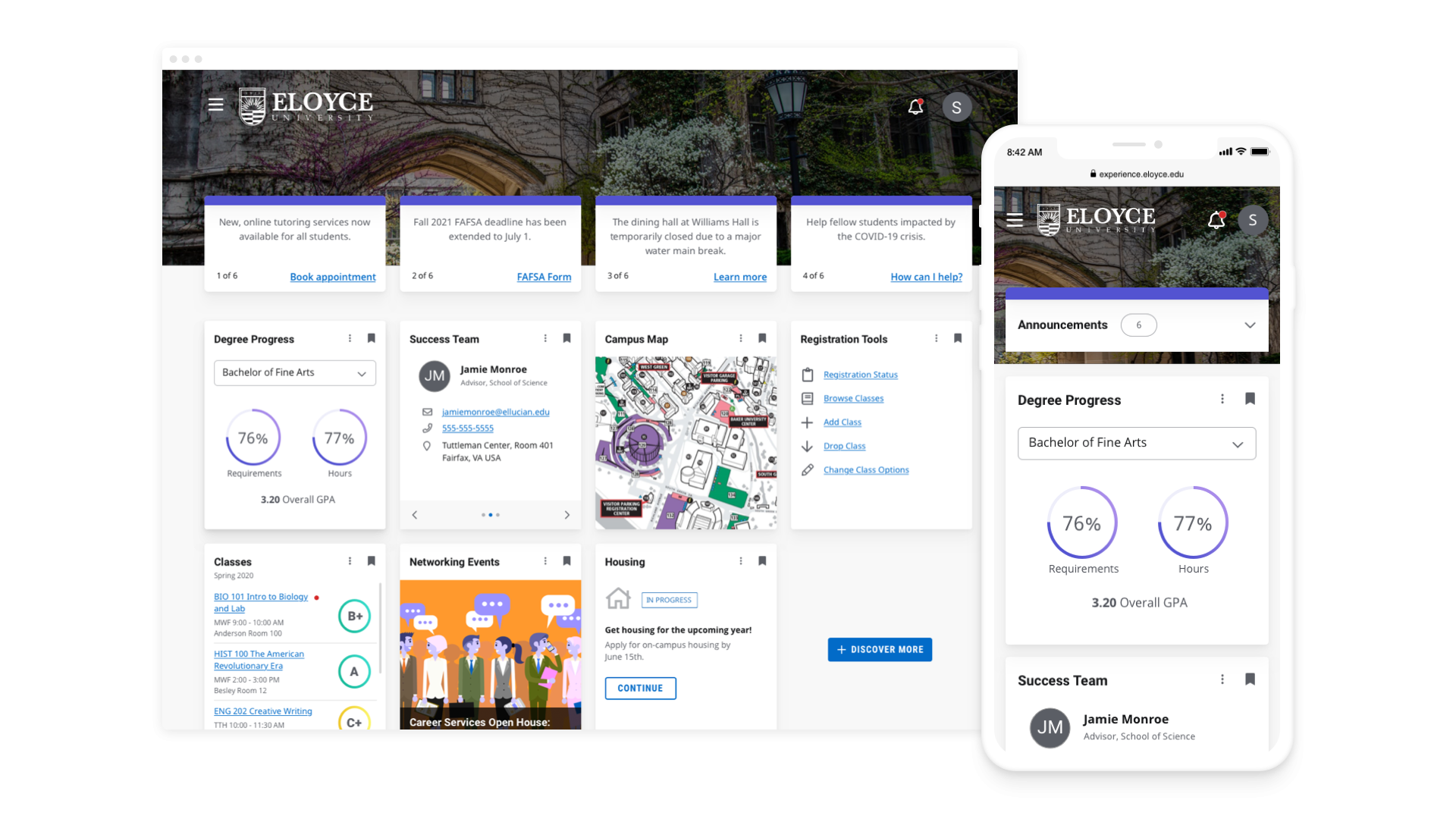
ellucian experience
A personalized information hub for college students based on 100+ hours of UX research.
in today’s age of instagram and google, students expect more from technology. why can’t they just have their grades, advisor information, and scheduling in one place?
the opportunityhow might we create a hub of information that is customizable by the college and shows the right information at the right time to students?
the solutionellucian experience
Note: I’m unable to show research findings or insights from this project, but will highlight some learnings through the UXD process.
-
Ellucian Experience is a responsive, personalized information hub for college students based on 100+ hours of student UX research.
-
Lead UX Researcher on the Ellucian Experience team.
-
November 2016 - January 2019
the ux process
-
1. discover: find meaningful differences in the student population to inspire design
-
2. ideate: concept test designs to define product vision
-
3. test and iterate: rapid design cycles with students and college administrators
1. discover: find meaningful differences in the student population to inspire design
phase 1 outcomesConduct large-scale research with college students to define archetypes and a framework to drive the product MVP
Deliver synthesized insights to UX team and product and engineering stakeholders
Create a framework for prioritizing student information needs based in research
key activities
50+ remote contextual inquiries with college students
Roll out findings to the research team without full analysis and synthesis to keep research going in parallel with design
key finding: designing a great experience needs to account for a growing nontraditional student population.
One of the biggest shocks to the team was the portion of traditional to nontraditional students in the college student population. (Nontraditional students are those coming into college financially independent, older than 18, caring for dependents, not living on campus and/or received a GED.) As of 2016, upwards of 40% of students are considered nontraditional. My research informed 2 “Student Hierarchies of Needs” frameworks: one for traditional and one for non-traditional. This guided UX designers in their prioritization of information for students based on who they are, where they are in their college journey, and what information the college needs to provide.
2. ideate: concept test designs to define product vision
phase 2 outcomesCreate diverging product concepts to test what traditional and nontraditional students value most
Recommend the direction of Ellucian Experience based on UX research
key activities
Plan, recruit, and facilitate 1-1 sessions with college students through a “speed dating” activity with 10+ storyboards and low-fidelity concepts
Conduct, analyze, and present findings in 1-month
key finding: traditional and nontraditional student information needs are similar but have different priorities
Overall, the idea of an information hub resonated well with students, but the most significant difference in the needs wasn’t around what information was shown, but in what order. Nontraditional students needed different information as their behaviors are different on campus. For instance, seeing their calendar in a different way was beneficial because nontraditional students live off campus and commute.
3. test and iterate: rapid design cycles with students and college administrators
Phase 3 outcomesRapid prototype the Ellucian Experience designs with 50+ college students
Provide research findings and recommendations every 2 weeks to keep UX design working
key activities
50+ unmoderated and moderated usability testing with traditional and nontraditional students
Support UX designers with creating prototypes and testing scripts
Key finding: keep the data flowing to stakeholders to prevent Ux research from becoming a bottleneck
Being a UX researcher provides many challenges, but one I hadn’t anticipated was the need to keep research recommendations flowing to the Ellucian Experience team. I had a large chunk of time to conduct the remote contextual inquiries, but work needed to happen fast to get an MVP ready to launch. To do this, I sent out research highlights every 2 weeks during multiple rounds of usability testing so the project team wasn’t waiting for results to keep working. It resulted in stakeholders seeing the value of the research because they had frequent communication from UX and observed quick design decisions being made.
The final mvp design1. a true one-stop shop for college students
No longer do students need to remember where to find which data. Now, everything is pulled in across their student information system (SIS) and learning management system (LMS), like Blackboard. Colleges can also promote events, remind students of important upcoming deadlines, and guide students toward relevant information.
2. responsive design that orders information in a student-centered way
A huge challenge to creating responsive information hubs is the order of information given. What’s first is what’s the biggest priority for users. Because of our several rounds of usability testing, UX could confidently design the flow of information to students.

